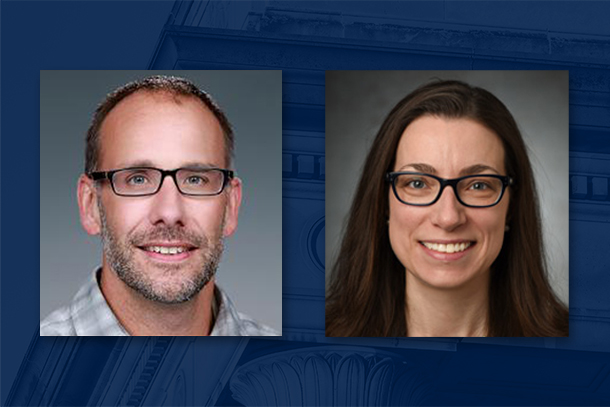
Jon Schwantes and Amanda Johnsen Credit: Penn State
Penn State partners on $25M nuclear forensics consortium
May 17, 2023
UNIVERSITY PARK, Pa. — Penn State researchers will join a University of Florida-led consortium of 16 universities to research areas related to nuclear forensics, an integral component of nuclear security within the United States. The Department of Energy (DOE)’s National Nuclear Security Administration (NNSA) is funding the $25 million cooperative agreement over five years.
“The purpose of this consortium is to educate the next generation of nuclear forensic scientists and engineers while engaging in research and development spanning basic aspects of new technology and methods to programmatic work directly supporting the nuclear security and nonproliferation missions of NNSA,” said a statement from the NNSA.
Amanda Johnsen, assistant professor of nuclear engineering, and Jon Schwantes, professor of nuclear engineering, will lead Penn State’s contributions.
Researchers and their students in the consortium will focus on five technical areas: rapid turnaround forensics, advanced analytical methods, ultrasensitive measurements, signature discovery, and prompt effects and measurements.
Johnsen will lead the signature discovery technical area.
“As nuclear proliferators strive to try to hide their activities, it becomes essential to develop novel detection signatures and to improve the quality of the nuclear data used in conjunction with these signatures,” she said.
Johnsen will also partner on novel experimentally derived signatures, leading a sub-objective to accurately measure short- and intermediate-lived fission product yields in intermediate- and high-energy neutron environments.
Schwantes will co-lead a cross-cutting focus area on enhanced training and international interactions with Ken Czerwinski, a professor at the University of Nevada, Las Vegas, and assist as the deputy lead for the advanced analytical methods thrust area, which will be led by Assel Aitkaliyeva, an associate professor at the University of Florida.
“We will work to engage all universities and national laboratories in the consortium, enhancing education and promoting collaboration with consortium members, DOE laboratory staff and leading forensics institutions worldwide,” Schwantes said. “A key goal is to dramatically shrink on-the-job training of consortium students entering post-doctoral research and DOE laboratory staff positions in the nuclear forensic enterprise.”
Schwantes’ research group will work to develop, test and demonstrate the world’s first Actinide Mössbauer Spectral Imager, with the aim of conducting “needle in the haystack” nondestructive detection and characterization of trace quantities of special nuclear materials within environmental samples.
“The role of universities for nuclear forensics research is to innovate and develop some of the most challenging and fundamental aspects of new technology and methods,” said Keith McManus, University Program Manager for Defense Nuclear Nonproliferation Research and Development at NNSA. “Once these basic aspects have been proven at the university level, the Department of Energy’s National Laboratories can fulfill their unique role to perform mission-specific research and development that improves on capabilities for adoption by operational enterprises.”
In addition to Johnsen and Schwantes, there is another consortium researcher with a Penn State connection. Kyle Hartig, assistant professor in the nuclear engineering program at the University of Florida, will serve as a co-principal investigator of the consortium. He earned his doctorate in nuclear engineering from Penn State in 2016.
The other consortium member institutions include Oregon State University; University of Nevada, Las Vegas; Texas A&M University; City University of New York; University of Michigan; University of Tennessee, Knoxville; University of Central Florida; Clemson University; North Carolina State University; Notre Dame; Iowa State University; South Carolina State University; George Washington University; and University of California, Berkeley. These 16 universities are partnering with seven national laboratories: Lawrence Berkeley National Laboratory; Lawrence Livermore National Laboratory; Los Alamos National Laboratory; Oak Ridge National Laboratory; Pacific Northwest National Laboratory; Sandia National Laboratories; and Savannah River National Laboratory.



